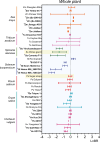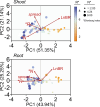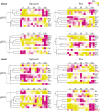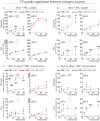Plant ammonium sensitivity is associated with external pH adaptation, repertoire of nitrogen transporters, and nitrogen requirement
- PMID: 38465958
- PMCID: PMC11358259
- DOI: 10.1093/jxb/erae106
Plant ammonium sensitivity is associated with external pH adaptation, repertoire of nitrogen transporters, and nitrogen requirement
Abstract
Modern crops exhibit diverse sensitivities to ammonium as the primary nitrogen source, influenced by environmental factors such as external pH and nutrient availability. Despite its significance, there is currently no systematic classification of plant species based on their ammonium sensitivity. We conducted a meta-analysis of 50 plant species and present a new classification method based on the comparison of fresh biomass obtained under ammonium and nitrate nutrition. The classification uses the natural logarithm of the biomass ratio as the size effect indicator of ammonium sensitivity. This numerical parameter is associated with critical factors for nitrogen demand and form preference, such as Ellenberg indicators and the repertoire of nitrogen transporters for ammonium and nitrate uptake. Finally, a comparative analysis of the developmental and metabolic responses, including hormonal balance, is conducted in two species with divergent ammonium sensitivity values in the classification. Results indicate that nitrate has a key role in counteracting ammonium toxicity in species with a higher abundance of genes encoding NRT2-type proteins and fewer of those encoding the AMT2-type proteins. Additionally, the study demonstrates the reliability of the phytohormone balance and methylglyoxal content as indicators for anticipating ammonium toxicity.
Keywords: Ammonium sensitivity; Ellenberg indicator; ammonium transporters (AMTs); high-affinity nitrate transporter (NRT2); methylglyoxal; nitrogen uptake; pH adaptation; phytohormonal balance.
© The Author(s) 2024. Published by Oxford University Press on behalf of the Society for Experimental Biology.
Conflict of interest statement
The authors declare no conflict of interest.
Figures











Similar articles
-
A nitrogen-dependent switch in the high affinity ammonium transport in Medicago truncatula.Plant Mol Biol. 2014 Nov;86(4-5):485-94. doi: 10.1007/s11103-014-0243-4. Epub 2014 Aug 28. Plant Mol Biol. 2014. PMID: 25164101
-
Evolutionary classification of ammonium, nitrate, and peptide transporters in land plants.BMC Evol Biol. 2014 Jan 20;14:11. doi: 10.1186/1471-2148-14-11. BMC Evol Biol. 2014. PMID: 24438197 Free PMC article.
-
Interaction of elevated CO2 and form of nitrogen nutrition alters leaf abaxial and adaxial epidermal and stomatal anatomy of wheat seedlings.Protoplasma. 2022 May;259(3):703-716. doi: 10.1007/s00709-021-01692-4. Epub 2021 Aug 10. Protoplasma. 2022. PMID: 34374877
-
Plant nitrogen assimilation and its regulation: a complex puzzle with missing pieces.Curr Opin Plant Biol. 2015 Jun;25:115-22. doi: 10.1016/j.pbi.2015.05.010. Epub 2015 Jun 1. Curr Opin Plant Biol. 2015. PMID: 26037390 Review.
-
Interactions between nitrate and ammonium in their uptake, allocation, assimilation, and signaling in plants.J Exp Bot. 2017 May 1;68(10):2501-2512. doi: 10.1093/jxb/erw449. J Exp Bot. 2017. PMID: 28007951 Review.
Cited by
-
Investigation of morpho-physiolgical traits and gene expression in barley under nitrogen deficiency.Sci Rep. 2024 Apr 17;14(1):8875. doi: 10.1038/s41598-024-59714-z. Sci Rep. 2024. PMID: 38632431 Free PMC article.
-
Functional crosstalk between nitrate and ammonium transporters in N acquisition and pH homeostasis.Front Plant Sci. 2025 Jun 27;16:1634119. doi: 10.3389/fpls.2025.1634119. eCollection 2025. Front Plant Sci. 2025. PMID: 40655555 Free PMC article. Review.
References
Publication types
MeSH terms
Substances
Grants and funding
LinkOut - more resources
Full Text Sources

